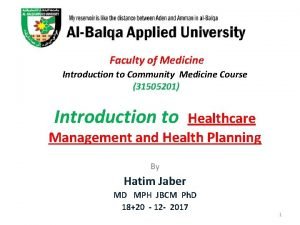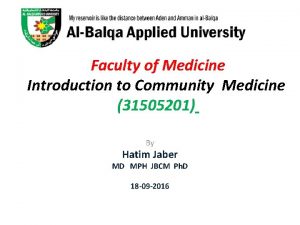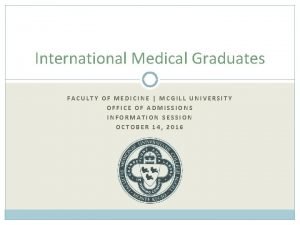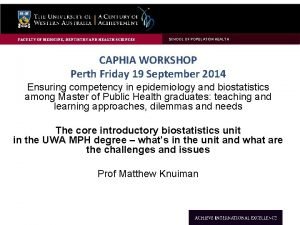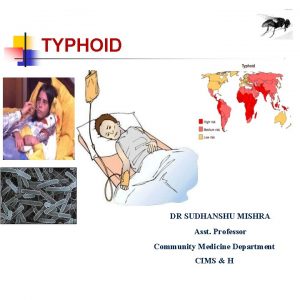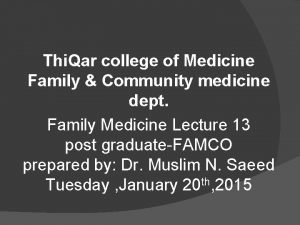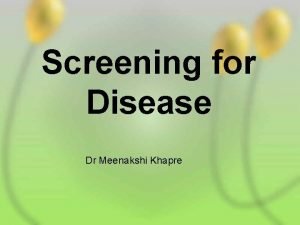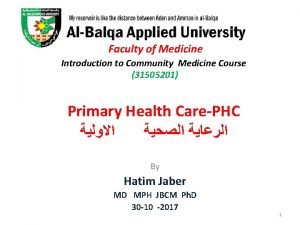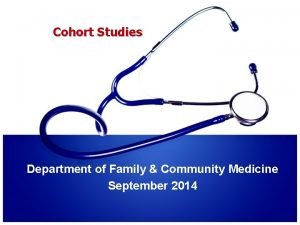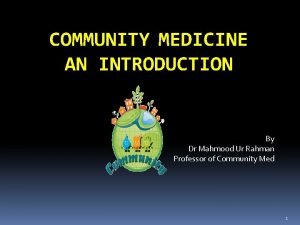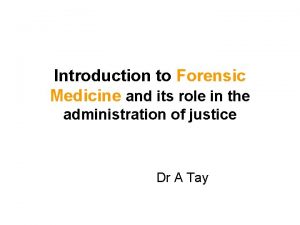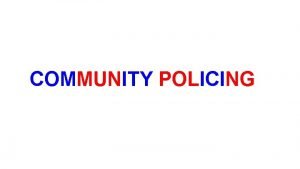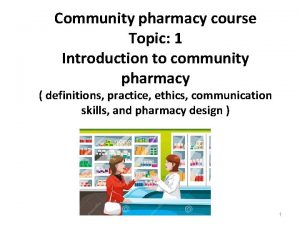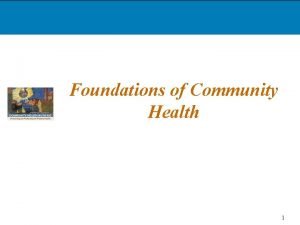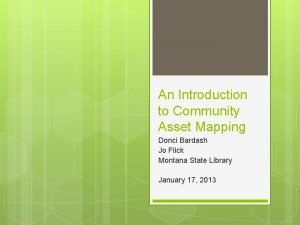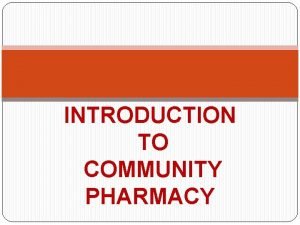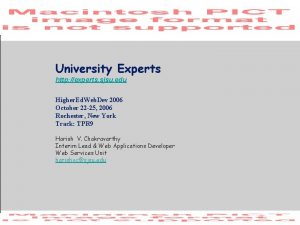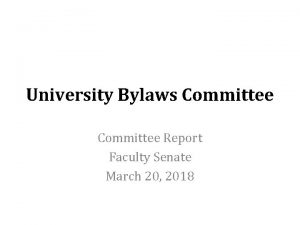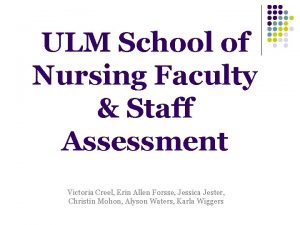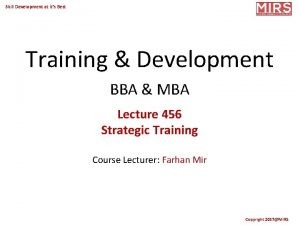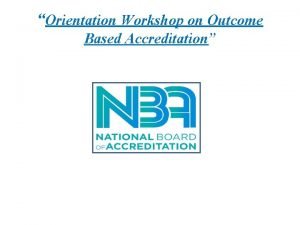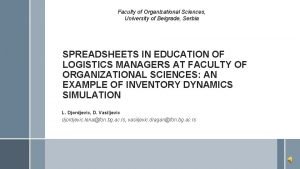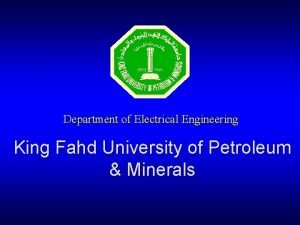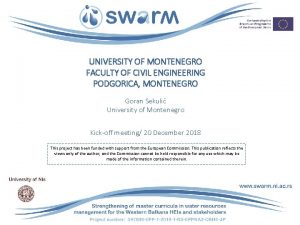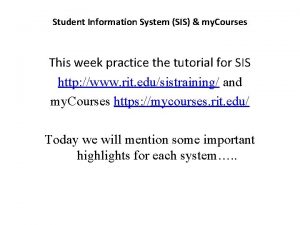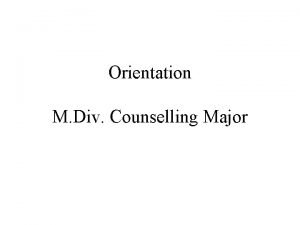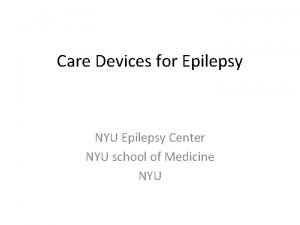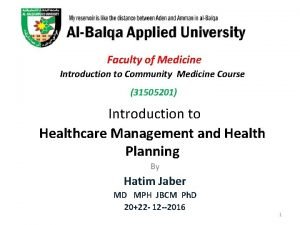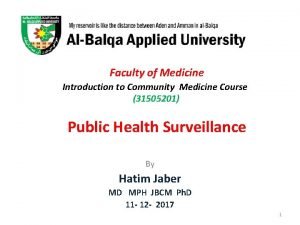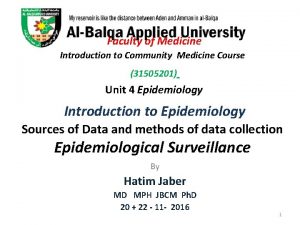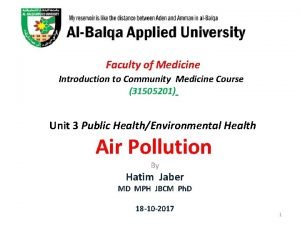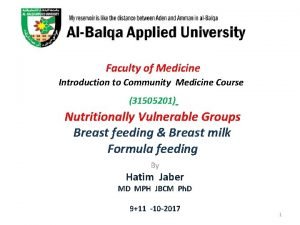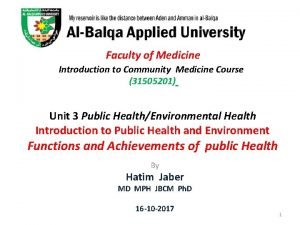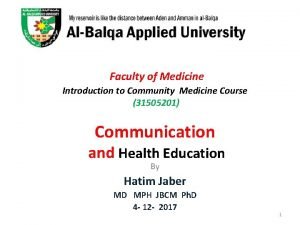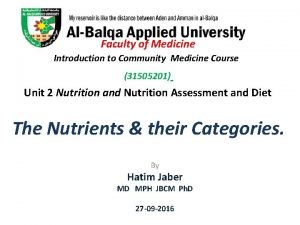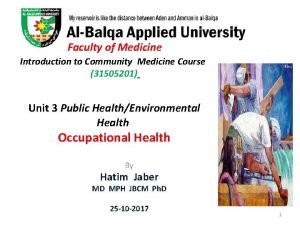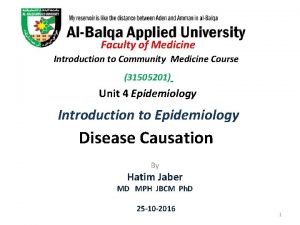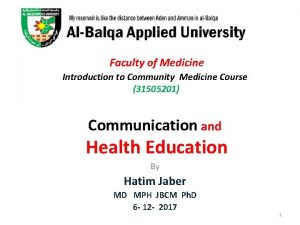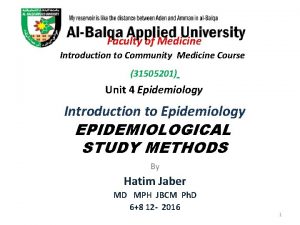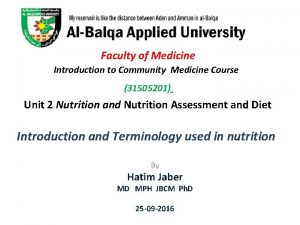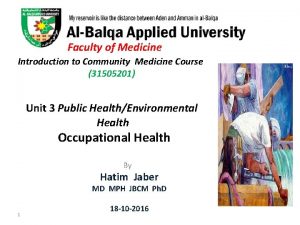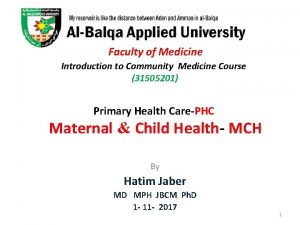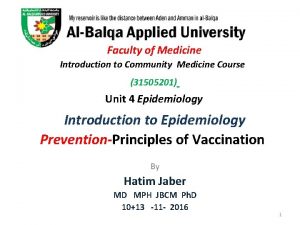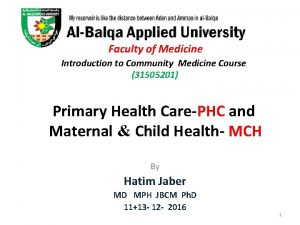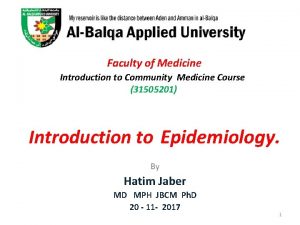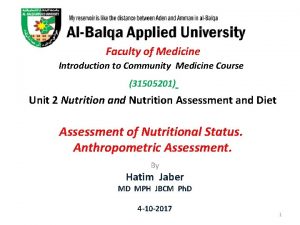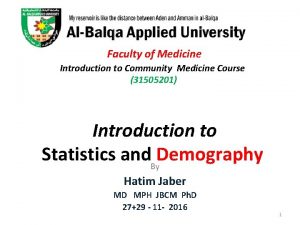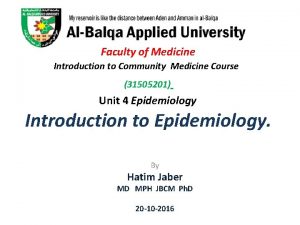Faculty of Medicine Introduction to Community Medicine Course




















































































































- Slides: 116

Faculty of Medicine Introduction to Community Medicine Course (31505201) Unit 3 Public Health/Environmental Health Introduction to Water pollution Food Safety Waste and Health By Hatim Jaber MD MPH JBCM Ph. D 23 -10 -2017 1


Every day in 2016, 15 000 children died before their fifth birthday, 46% of them – or 7 000 babies – died in the first 28 days of life, according to a new UN report.

Introduction to Unit 3 Public Health and Environment 4 lectures 1. Introduction to Public Health and Environment-- 16 -102017 2. Environment 1 - Air pollution— 18 -10 -2017 3. Environment : introduction to Water Quality and water borne diseases Food Safety and food borne diseases Waste and health- Management 23 -10 -2017 4. Occupational Health -25 -10 -2017 4

Presentation outline Time Water Quality, Quantity and Health Water pollution and Sources Water and contaminations 08: 15 to 08: 25 Water related diseases 08: 25 to 08: 40 Food Safety and health Food borne Diseases and HACCP 08: 40 to 09: 00 Waste definition and classification Waste and Health. Solid Waste Management Waste Occupational Health Hazards Healthcare/Hospital Waste 09: 00 to 09: 15 to 09: 30 5



Water Quality and Health • The quality of drinking-water is a powerful environmental determinant of health • Water is essential for life, but it can and does transmit disease in countries in all continents – from the poorest to the wealthiest. • The most predominant waterborne disease, diarrhoea, has an estimated annual incidence of 4. 6 billion episodes and causes 2. 2 million deaths every year • Millions of people are exposed to unsafe levels of chemical contaminants in their drinking-water

• In 2015, 71% of the global population (5. 2 billion people) used a safely managed drinking-water service – that is, one located on premises, available when needed, and free from contamination. • 844 million people lack even a basic drinking-water service, including 159 million people who are dependent on surface water. • Globally, at least 2 billion people use a drinking water source contaminated with faeces. • Contaminated drinking water is estimated to cause 502 000 diarrhoeal deaths each year. • In low- and middle-income countries, 38% of health care facilities lack an improved water source, 19% do not have improved sanitation, and 35% lack water and soap for handwashing.

How much water does an individual use?


In Jordan


Water supply per Capita (2000 -2013)

General information of water sources Sources Quality Quantity Good quality for deep Good with little Groundwater aquifers; poor to fair variation for shallow aquifers Good with little variation for artesian flow springs; variable with seasonal fluctuations likely for gravity flow springs. Springs and Seeps Good quality; disinfection recommended after installation of spring protection. Ponds and Lakes Fair to good in large ponds and lakes; poor Good available to fair in smaller quantity; decrease water bodies; during dry season. treatment generally necessary. Accessibility Reliability Cost Depends on the best location of well; pumping required unless artesian well Good, maintenance on Moderate if need pump required to pump regularly, must not over pump the aquifer Good for artesian Storage necessary flow and gravity for community overflow; fair for Fairly low cost; water supply; gravity with piped system depression; little gravity flow costs will rise. delivery for easy maintenance community access. needed after installation. Very accessible using intakes; pumping required for delivery system; storage required. Fair to good; need for a good program of operation and maintenance for pumping and treatment systems. Moderate to high because of need to pump and treat water.

Information of water sources Sources Quality Quantity Accessibility Reliability Cost Good for mountain streams; poor for Streams and streams in lowland Rivers regions; treatment necessary. Maintenance required for both Moderate: seasonal Generally good; type systems; variation likely; need intake for much higher for some rivers and both gravity flow pumped system; streams will dry up and piped riverside well is a in dry season. delivery. good reliable source. Moderate to high depending on method; treatment and pumping expensive. Fair to poor; Rain disinfection Catchments necessary Moderate and variable; supplies unavailable during dry season; storage necessary. Low-moderate for roof catchments; high for ground catchments Good; cisterns located in yards of users; fair for ground catchments. Must be rain; some maintenance required.

What’s the Quality of Our Drinking Water? Drinking water is defined as potable water used for domestic purposes, food, industries, and ice manufacturing. Community asks for information: Sodium Hardness Mineral content (TDS) p. H Chlorine Coliform Bacteria Contamination

Standard conditions 1 Microbial Parameters 1. 1 The maximum allowable limit for the TCC (MPN/100 ml) should be < 1. 1 as a result of the Multiple Tube Test and 0 as result of the Membrane Filtration Test. 1. 2 The sample should be free from a) Thermo tolerant coli form bacteria, and b) Enteric viruses and germs 2 Biological Parameters: Drinking water should be free from a) Any pathogenic protozoa b) Any pathogenic nematode eggs c) Any free living pathogens, and d) Fungus. 3 Physical Characteristics The physical characteristics of water should be as follows: a) Taste: Acceptable for the majority of people b) Odor: Acceptable for the majority of people c) Color: The maximum allowable limit is 10 units – 15 units d) Turbidity: The maximum allowable limits is 1 – 5 NTU. 4 Chemical Characteristics Where chlorine is used to disinfect the drinking water, the maximum allowable limit for free chlorine supplied to the consumer is 0. 2 -1 mg/l after 15 minutes from disinfection and 15 minutes before arriving to the consumer. Parameters Related to Water Taste read as indicated in the following table. Note that the lower range level is obligatory for private wells.

Primary drinking water standards criteria • Microorganisms - Giardia lamblia; Virus; Legionella; Turbidity • Disinfection Byproductsbromate, chlorite, trihomethanes; haloacetic acids • Disinfectantschloramines, chlorine and chlorine dioxides • Inorganic Chemicals – Arsenic, barium, fluoride, copper, lead, • Organic Chemicals – Benzine; Carbon tetrachloride; Dichloromethane • Radionuclides – Uranium; Alpha particles; Beta particles and photon emitters

Secondary - Drinking water standards Contaminant Aluminum Chloride Color Copper Corrosivity Fluoride Foaming Agents Iron Manganese Odor p. H Silver Sulfate Total Dissolved Solids Zinc Secondary Standard 0. 05 to 0. 2 mg/L 250 mg/L 15 (color units) 1. 0 mg/L noncorrosive 2. 0 mg/L 0. 5 mg/L 0. 3 mg/L 0. 05 mg/L 3 threshold odor number 6. 5 -8. 5 0. 10 mg/L 250 mg/L 500 mg/L 5 mg/L



Community actions to improve WQ Source of pollution Agricultural: from both agriculture practices and livestock rearing. Storm water: Generated by rainfall storms Sewer Industrial What the communities can do o Managing pastures to maintain vegetative cover and stable soils o Employing conservation farming technique o Minimizing stock access to streams and damage to stream banks o Actively controlling erosion problems Constructing farm dams to encourage water plant growth so that they act as filters for run-off o Maintaining and operating on-site household wastewater systems (septic tanks and aerated wastewater treatment units) to prevent nutrients getting into streams or groundwater o regulating industrial activities, as well as controlling diffuse sources, to prevent water pollution o Protecting local wetlands for their role in filtering sediment and nutrients and providing a diversity of wildlife habitat o Reusing effluent where possible

Methods for purification • • Simplest is boiling Filtration Chlorination Ozone UV treatment Water guard (Sodium hypo chlorite) Distillation

Filters • • Sand filters for large communities Gravity filters for small communities Domestic household filters Filter cartridges ( for many types of ions) Activated carbon or charcoal filters Fluoride filters – CDN as a leader Reverse osmosis – More advanced

The working principles of some specific filters 1. Ozone filters – Through oxidation process, all organic, inorganic and biological substances are destroyed 2. Steam distillation – Natural methods which is able to remove Biological Entities, Heavy Metals, Organic Chemicals, Inorganic Chemicals & Radioactive Material 3. Carbon filters (Charcoal) – A good media for a wide range of contaminant like chlorine, pesticides, herbicides and inorganic materials 4. Far Infrared Light (FIR) - Very suitable for toxin removal 5. Ultraviolet Light – Very cheap to use – Deactivates the DNA of bacteria, virus and other pathogens

6. The ceramic water filters – Very cheap and affordable- removes dirt, microbes, virus and bacteria 7. CDN Fluoride filters- Single and combined “These two filters are cheap and wananchi friendly”

Sand filters

UV filters

Ceramic water filters

CDN Single and combined Fluoride filters

Water pollution and Water related diseases

Pollutants Found in Runoff Sediment Soil particles transported from their source Biochemical Oxygen Demand (BOD) ● Oxygen depleting material ØLeaves ØOrganic material Toxics ● Pesticides Ø Herbicides Ø Fungicides Ø Insecticides ● Metals (naturally occurring in soil, automotive emissions/ tires) Ø Lead Ø Zinc Ø Mercury ● Petroleum Hydrocarbons (automotive exhaust and fuel/oil) Debris Litter and illegal dumping Nutrients ● Various types of materials that become dissolved and suspended in water (commonly found in fertilizer and plant material): Ø Nitrogen (N) Ø Phosphorus (P) Bacteria/ Pathogens Originating from: ● Pets ● Waterfowl ● Failing septic systems Thermal Stress Heated runoff, removal of streamside vegetation

Major Water Pollutants and Their Sources

Common Diseases Transmitted to Humans through Contaminated Drinking Water

What Can You Do? Water Pollution, Ways to Help Reduce Water Pollution

Diseases Related to Waterborne Diseases Water-washed Diseases Water-based Diseases Water-related Diseases

Water-borne Diseases caused by ingestion of water contaminated by human or animal excrement, which contain pathogenic microorganisms Include cholera, typhoid, amoebic and bacillary dysentery and other diarrheal diseases

• • • Arsenic Flouride Nitrates from fertilizers Carcinogenic pesticides (DDT) Lead (from pipes) Heavy Metals

Water-washed Diseases caused by poor personal hygiene and skin and eye contact with contaminated water These include scabies, trachoma, typhus, and other flea, lice and tick-borne diseases.

Water-based Diseases caused by parasites found in intermediate organisms living in contaminated water Includes Schistosomiasis and Dracunculiasis

Water-related Diseases Water-related diseases are caused by insect vectors, especially mosquitoes, that breed or feed near contaminated water. They are not typically associated with lack of access to clean drinking water or sanitation services Include dengue, filariasis, malaria, onchocerciasis, trypanosomiasis and yellow fever

Other Water-borne diseases • Bathing • Swimming • Other recreational activities that have water contact • Agriculture • Aquaculture

The Problem • ~80% of infectious diseases • > 5 million people die each year • > 2 million die from water-related diarrhea alone • Most of those dying are small children • Lost work days Other Consequences • Missed educational opportunities • Official and unofficial healthcare costs • Draining of family resources

Food Safety and health

Food security and safety • Food security: availability of the right quality and quantity of food to supply the recommended daily nutrients to maintain good health and prevent malnutrition. • Food safety: reflection of food sanitation and is related to safeguarding from the immediate or late health hazards resulting from biological, chemical , or physical contamination of food ( production, transport, distribution, processing, and subsequent use are properly handled )

What is Food Safety? Food Safety is making a food safe to eat and free of disease causing agents such as: • Too many infectious agents • Toxic chemicals • Foreign objects

What is Food Quality? Food Quality is making a food desirable to eat with regards to good taste, color, and texture; bad food quality can be judged by: • Bad color • Wrong texture • Smells bad • Temperature

• Adulteration, contamination of food is major cause of ill health. • The GIT is the usually portal of entry for many infectious and parasitic organisms. • Food stuff readily become contaminated through human, insects and other intermediaries. • Control of the cleanliness and composition of food is clearly important but it is more complex and difficult than ensuring a safe water supply

Food preservation: Dehydration ( Drying ) Osmotic inhibition Heating to kill micro organisms Oxidation (eg. Use of sulphur dioxide ) Toxic inhibition (eg. smoking ). Low temperature inactivation (freezing ) Vacuum -packing

What are the Types of Food Hazards? • Biological: bacteria, viruses, parasites • Chemical: heavy metals, natural toxins, sanitizers, pesticides, antibiotics • Physical: bone, rocks, metal

Biological Hazards in Food Biological = Living Organisms In Meat and Poultry: • Salmonella bacteria (poultry and eggs) • Trichinella spiralis parasite (pork) On Fruits and Vegetables: • E. coli bacteria (apple juice) • Cyclospora parasite (raspberries) • Hepatitis A virus (strawberries)

Chemical Hazards in Food Chemical hazard: a toxic substance that is produced naturally added intentionally or un-intentionally • Naturally-occurring: – Natural toxins (aflatoxins, marine toxins) • Added intentionally: – Antibiotics, preservatives • Added non-intentionally: – Cleaning agents, Pesticide Residues

Physical Hazards in Food Physical hazard: a hard foreign object that can cause illness or injury • Inherent to the food or ingredient – Bone fragment, feathers • Contaminant during processing – Stones, rocks, dirt, fingernails

Food borne Diseases

What are the foodborne illness risk factors Food from unsafe source Inadequate cooking Improper holding temperature Contaminated equipment Poor personal hygiene

Microbiological pathogens Food poisoning Infective food poisoning Occurs as a result of eating food contaminated with bacteria itself Examples; Salmonella, Listeria and Escherichia coli. Toxic food poisoning Some bacteria produce toxins , these toxins cannot be removed or inactivated by cooking. Examples Staphylococcus aureus, Clostridium perfringens

What is a Foodborne Illness? Foodborne illnesses are caused by agents that enter the body through the ingestion of food. • Every person is at risk of foodborne illness. • May be serious for very young, very old, people with long term illness • Reaction may occur in a few hours or up to several days after exposure Symptoms • Abdominal cramps, headache, vomiting, diarrhea (may be bloody), fever, death

What is the Impact of Foodborne Illness? • The global incidence of foodborne disease is difficult to estimate • Up to 30% of the population annually • Diarrhoeal disease is the second leading cause of death in children under five years old. It is both preventable and treatable. • Each year diarrhoea kills around 525 000 children under five. • A significant proportion of diarrhoeal disease can be prevented through safe drinking-water and adequate sanitation and hygiene. • Globally, there are nearly 1. 7 billion cases of childhood diarrhoeal disease every year. • Diarrhoea is a leading cause of malnutrition in children under five years old – Food & Water Contamination – Malnutrition & Death in Infants & Children

Hazard Analysis Critical Control Point Hazard Analysis and Critical Control Point (HACCP)

The HACCP ä It is the system that is required for any food business or organisation in most countries. ä The joint FAO / WHO Codex Alimentarius Commission recommends the HACCP approach to enhance Food Safety in all process of food production. äThe goal of HACCP is to prevent and/or minimize risks associated with biological, chemical, and physical hazards to acceptable levels


What are the Steps involved in HACCP? 1. Identify hazards 2. Determine Critical Control Points (CCPs) 3. Determine safety limits for CCPs 4. Monitor CCPs 5. Corrective action 6. Record data 7. Verify that the system is working

Waste and Health 64

Waste Definition : Waste material are unwanted substance because the good part of them has been use or removed WASTE is the by- product of human activities. 65

TYPES OF WASTES 1. Human body wastes: urine and feces 2. Excess materials and foods: trash and garbage 3. Vegetation wastes: grass clippings and tree branches 4. Construction and manufacturing wastes (including excess heat and noise). 5. Transportation wastes: carbon monoxide, nitrous oxides, hydrocarbons, other gaseous pollutants and used motor oil 6. Energy production wastes: mining wastes, electrical power (combustion of coal), nuclear power (radioactive) wastes and weapons production (radioactive) wastes

Types of waste • Non Hazardous waste: refuse, garbage, sludge, municipal trash. • Hazardous waste: solvents acid, heavy metals, pesticides, and chemical sludge • Radioactive: high and low-level radioactive waste • Mixed waste: Radioactive organic liquids, radio active heavy metals. ” ( Moeller, 2005).

Forms of waste • • Solid= refuse Liquid= sewage Gaseous Radioactive • Hazardous • Nonhazardous

Characteristics of wastes • Corrosive: these are wastes that include acids or bases that are capable of corroding mental containers, e. g. tanks • Ignitability: this is waste that can create fires under certain condition, e. g. waste oils and solvents • Reactive: these are unstable in nature, they cause explosions, toxic fumes when heated. • Toxicity: waste which are harmful or fatal when ingested or absorb.

Waste components

Jordan


Other Definitions The following definitions are intended to serve as a guide and are not meant to be arbitrary or precise in scientific sense 1. Food waste( garbage): - Food waste are the animal, fruit or vegetable residues resulting from handling, preparation, cooking and eating of food. Often , decomposition lead to development of offensive odors. 2. Rubbish: - it consist of combustible and non combustible solid waste of residential and commercial activities, excluding food waste. 3. Ashes and residues: - Materials remaining from the burning of wood, coal, coke and other combustible waste. 4. Demolition and construction waste: - Demolition waste are waste from razed building and other structures. 5. Special Waste Are street sweepings, litter from municipal containers, dead animals and abandoned vehicles. 6. Treatment plant waste: Include solid and semisolid from water, waste water • and waste treatment plant or facilities. 7. Agriculture Waste: - Results from diverse agricultural activities such as planting and harvesting of field crops, tree, the production of milk, production of animals for slaughter, animal excreta. 8. Hazardous waste: These are chemical, biological, flammable, explosive or radioactive waste which pose a substantial danger (immediately or over time) to human, animal or plant life. Usually occurs as liquid, but some times as gases or solid. 9. Green house effect: fluochlorocorbens destroy ozone layer which protect the 73 earth from ultraviolet rays.

Relation of waste with environment The relationship between environment and improper storage, collection and disposal of waste is quite clear. Public health authorities have shown that rats, flies, and other disease vector bread in open dumps and as well as in poorly constructed or poorly maintained housings, in food storage facilities. The US Public health services (USPHs) has publish the result of a study tracing the relation 22 human diseases to improper solid waste management. Data are also available to show that the illness/accident rate in sanitation workers is several time higher than industrial employees. 74

Ecological impact, such as water - and air pollution, also have been attributed to improper management of solid waste. For example liquid from dumps and poorly engineered landfills have contaminated surface and ground water. - In mining are the liquids leached from waste dumps may contain toxic element or may contaminate water supply with unwanted salts of calcium and magnesium. 75

What is solid waste • Solid waste is defined as any garbage, refuse, sludge from waste treatment plant, water supply treatment plant, or air pollution control facility and other materials, including solid, liquid, semisolid, contained gaseous resulting from industrials, commercials, mining and agricultural operations from community activities ( Moeller, 2005).

Causal of increase in solid waste Population growth Increase in industrials manufacturing Urbanization Modernization, technological advancement and increase in global population created rising in demand for food and other essentials. This has resulted to rise in the amount of waste being generated daily by each household. • •

Impacts of solid waste on health Chemical poisoning through chemical inhalation Uncollected waste can obstruct the storm water runoff resulting in flood Low birth weight Cancer Congenital malformations Neurological disease

Impacts of solid waste on health • Nausea and vomiting • Increase in hospitalization of diabetic residents living near hazard waste sites. • Mercury toxicity from eating fish with high levels of mercury.

Impacts of solid waste on Environment. • Waste breaks down in landfills to form methane, a potent greenhouse gas • Change in climate and destruction of ozone layer due to waste biodegradable • Littering, due to waste pollutions, illegal dumping, Leaching: is a process by which solid waste enter soil and ground water and contaminating them. • U. S. Environment Protection Agency (2009)

Disposal is the final disposition of solid wastes in such a way as to prevent them from harming the environment or human health. i. Sanitary landfills are sites or locations judged suitable for the in-ground disposal of solid wastes. ii. Incineration is the burning or combustion of solid wastes. iii. Recycling (resource recovery) is the collection and reprocessing of a solid waste "resource" so it can be reused. iv. Source reduction is the reduction in, or elimination of use of materials that could become solid waste.

Solid waste Disposal Methods There is many methods of solid waste disposal the choice dependent upon cost and availability of land labor 1. Dumping: - dumping in low lying area 2. Controlled tipping: - it differ from ordinary dumping that it is covered with earth at the end of the day. 3. Incineration: - Best for Hospital refuse by burning or where the place is not available. 4. Composting: - refuses and night soil or sludge together its end product is compost (samad) which contain nitrogen 5. Manure pits: - In villages where there is no system of waste collection a hole can be dig and waste in dump in it and everyday it is covered with earth when one is full other hole is dug. 6. Burial : - Suitable for small camps 82

II- HAZARDOUS WASTES are those that are dangerous to human health or to the environment. Hazardous wastes are solid wastes that can: a. Cause or significantly contribute to an increase in mortality or an increase in serious irreversible, or incapacitating, reversible illness. b. Pose a substantial present or potential hazard to human health or the environment when improperly treated, stored, transported, or disposed of, or otherwise managed.

Special or Hazardous waste Special waste include those from hospitals, animal slaughter wastes and industrial waste. These wastes are better to be described under title “hazardous waste” 84

Why they are considered hazardous? - Being non – degradable or persistent in nature - Can be biologically magnified. - Can be lethal - Many cause or tend to cause detrimental cumulative effects. 85

Methods must be developed for - Storage - Handling - Transport - Recycling and - Disposal of such wastes i. e. management of these waste are highly specialized and controlled. 86

Classification of hazardous waste Hazardous waste are considered in five categories 1. Radioactive 2. Chemical 3. Biological 4. Flammable 5. Explosive waste 87

(1) Radioactive substances Are those emitting ionizing radiation. Sub substance are hazardous because prolonged exposure to radiation often result in cancer or other genetic disorders. These radioactive substance may remain active for millions of years. Biological half life of U 232 =72 years U 236 = 23, 420, 000 years Radio active waste management is not responsibility of municipality. 88

Symptoms of radiation It can range from Headache, dizziness and vomiting, burning, hair fall to much more serious problems. Because it is genotoxic, it may also effect genetic material. 89

(2) Chemicals: - Most of chemical are highly toxic, genotoxic, corrosive, flammable, explosive. They can cause intoxication, burn or injuries. They can be classified into 4 groups. - Synthetic organic - Inorganic metals - Flammables - Explosive 90

(3) Biological The ability to infect other living organisms and ability to produce toxins are the most significant characteristics of a hazardous biological waste. Such as - needles - bandages - outdated drugs - malignant tissue during surgery - by products of industries biological conversion process 91

(4) Flammables: These may be in liquid; gaseous or solid forms. Typical example include organic solvent. Oil, plasticizers and organic sludge's. (5) Explosive: As flammables and have potential hazards in storage and disposal. 92

Hazardous waste management a. Secured landfills are the least expensive method of hazardous waste disposal when they are: i. Carefully designed and located ii. Monitored for leakage b. Deep well injection is the pumping of liquid hazardous waste into wells below the aquifer. c. Incineration of hazardous waste is the controlled combustion of hazardous waste. d. Hazardous waste recycling is the process of reusing hazardous waste to produce a usable product, a process sometimes accomplished through "waste exchanges" in Europe.

e. Neutralization of hazardous waste is the process of detoxifying the waste so it is less toxic, corrosive, or otherwise hazardous. f. Source reduction is the alteration of manufacturing processes to reduce or eliminate the generation of hazardous waste. 3. Hazardous waste cleanup a. Since the disposal of hazardous waste was unregulated before 1976, there exist many hazardous waste sites around the United States. b. The "Superfund" Law (CERCLA) was passed in 1980 and amended in 1986 to clean up such sites.

Liquid waste (sewage) disposal Definition: - “Sewage” is waste water from a community containing solid and liquid excreta derived from houses, street, yard washing and factories. The term “sludge” is applied to waste water which does not contain human excreta. For example waste water from kitchen and bath rooms. Composition of sewage 99 % of water Partly organic 1 % of solid Partly inorganic 95

Disease agent present in excreta Liquid waste contain several microorganism particularly useful and harmful bacteria the organism may reach several millions per cubic centimeter of liquid waste. Most of bacteria, worms and insect larvae as well as algae considered useful organism that play on important role in treatment of liquid waste, particularly stabilizing the organic matter, which on anaerobic decomposition cause black coloration. 96

A. Virus: - as those causing Poliomyelitis Epidemic viral hepatitis (A) and Viral gastroenteritis (rotavirus) B. Bacteria: i. As those causing: - Cholera Enteric fever Typhoid Paratyphoid Bacillary dysentery, Malta fever, T. B food poisoning: - infective (salmonella F. P) - intoxication – Staphylococcal - Botulism - Cl. Welch ii. Coliform Bacteria: - especially E. coli which is used as an indicator of water pollution with human waste, as it is present in the G. I. T. of healthy and diseased person iii. Fungi and yeast: - e. g. C. albicans which cause monilial infection iv. Parasites: - e. g. a. Cyst of amoebiasis b. Ova of Ascaris, Ancylostoma, trichuris, hetrophytes, tapeworms, bilharzia. c. The parasite it self e. g. Traphazrites of trachomenas, Ascaris worms, parts of tape worm 97

Healthcare/ Hospital Waste

• Hospital waste include all waste arising from healthcare establishments. Health care waste 1. 80% can be dealt with normal domestic and urban waste management. 2. 15% pathological waste 3. 1% sharp waste 4. 3% Chemical and pharmaceutical waste 5. less than 1% special waste such as radioactive , cytotoxic, or pressurized container , broken thermometer and batteries Total waste per bed range from ½ to 4 kg 99

Responsibility for Waste Management • Waste Management Team of the Hospital/ Clinic/ Lab. shall be responsible to ensure proper management of the waste generated in the Hospital/ Clinic/ Lab. • Preparation and Monitoring of Plan • • Periodic Review • • Revision or updating • • Implementation of WMP • • Compliance

Waste Segregation • Waste Segregation z Different color coding has to be assigned to various waste for effective segregation, as: • i. Black : Non-Risk waste. • ii. Red: Risk waste with Sharps. • iii. Blue: Risk Waste without sharps. • iv. Yellow: Radioactive waste • v. Green: Chemicals like Mercury & Cadmium All this segregation should be done by the individual user.

INFECTIOUS WASTE MANAGEMENT PLANS Components of an Infectious Waste Management Plan: 1. Designation of the waste that should be managed as infectious 2. Segregation of infectious waste from the noninfectious waste 3. Packaging 4. Storage 5. Treatment 6. Disposal 7. Contingency measures for emergency situations 8. Staff training

Color coding and type of container for disposal of biomedical waste Color coding Yellow Red Blue/ white translucent Black Type of container Plastic bag Waste category 1, 2, 3, 6 Treatment option incinerator/ deep burial Disinfected container/ 3, 6, 7 plastic bags Autoclaving, / microwaving/ chemical Plastic bags/puncture proof container 4, 7 Autoclaving, / microwaving/ chemical treatment and destruction and shredding Plastic bags 5, 9, 10 Disposal in secured land fill. 103

Best Practice Colour Coding


Sharps n Must be collected at the point of generation, in a leakproof and puncture-resistant container n Containers must bear the international biohazard symbol and appropriate wording n Containers should never be completely filled, nor filled above the full line indicated on box.

Generator’s Section Transporter’s Section Treatment Facility’s Section

Main Principles of Solid Waste Management • Reduce • Reuse • Re-cycle We all can save the Earth

Image: Fairfax County Solid Waste Management Integrated Solid Waste Management: • A set of plans to manage solid waste • Adopted by many governments • A means of achieving sustainability

Waste treatments • Incineration: • Solidification: solid waste are melted or evaporated to produce a sand like residue. • Heat treatment: Heat applied at moderate temperature, is used in treating volatile solvents. • Chemical treatment: is the application of chemical treatment in the treatment of corrosive solid.

Waste Disposal • Landfills: waste is placed into or onto the land in disposal facilities. • Underground injection wells: waste are injected under pressure into a steel and concrete-encased shafts placed deep in the earth. • Waste piles: is accumulations of insoluble solid, non flowing hazard waste. Piles serves as temporary or final disposal.

Waste Disposal • land treatment: is a process in which solid waste, such as sludge from wastes is applied onto or incorporated into the soil surface. • Waste are disposed in flowing rivers in less developed countries. Moeller, D. W. (2005). Environmental Health (3 rd ed. ). Cambridge, MA: Harvard University Press

Groups at risks due to solid waste The groups at risk from the unscientific waste disposal include: • Populations in areas where there is no proper waste treatment method. • Children • Waste workers • Populations living close to waste dump • Animals

SOURCES OF HUMAN EXPOSURES Exposures occurs through • Ingestion of contaminated water or food • Contact with disease vectors • Inhalation • Dermal

PREVENTIVE MEASURES • Proper management of solid waste • Involving public in plans for waste treatment and disposal • Provide the public accurate, useful information about the whole projects, including the risks and maintain formal communication with public • Educate people on different ways of handling waste.

PREVENTIVE MEASURES Waste Minimization is a process of reducing waste produce by individuals, communities and companies, which reduces the impact of chemical wastes on the environment to the greatest extent. Household level of proper segregation of waste, recycling and reuse. Process and product substitution e. g. use paper bag instead of plastic bags. Moeller, 2005
 Introduction to community medicine
Introduction to community medicine Introduction to community medicine
Introduction to community medicine Hubert kairuki memorial university faculty of medicine
Hubert kairuki memorial university faculty of medicine Semmelweis
Semmelweis Faculty of medicine nursing and health sciences
Faculty of medicine nursing and health sciences Applied medical sciences
Applied medical sciences Semmelweis university faculty of medicine
Semmelweis university faculty of medicine Faculty of veterinary medicine cairo university logo
Faculty of veterinary medicine cairo university logo Hacettepe university faculty of medicine
Hacettepe university faculty of medicine دانشگاه دامپزشکی تهران
دانشگاه دامپزشکی تهران Semmelweis university faculty of medicine
Semmelweis university faculty of medicine Faculty of medicine mcgill
Faculty of medicine mcgill Faculty of veterinary medicine cairo university
Faculty of veterinary medicine cairo university Pubh4401
Pubh4401 Coumadin clinic emory
Coumadin clinic emory Cairo university faculty of veterinary medicine
Cairo university faculty of veterinary medicine Faculty introduction speech
Faculty introduction speech Cut brick lengthwise
Cut brick lengthwise Course title and course number
Course title and course number Chaine parallèle muscle
Chaine parallèle muscle Drinking water
Drinking water Lt lead time
Lt lead time Types of family in community medicine
Types of family in community medicine Concept of lead time
Concept of lead time Kashif rahim
Kashif rahim Basic requirements for sound phc
Basic requirements for sound phc Cohort study community medicine
Cohort study community medicine Duke medicine grand rounds
Duke medicine grand rounds Seqs community medicine
Seqs community medicine Plan together in community mobilization
Plan together in community mobilization Introduction to banking course
Introduction to banking course Imbe introduction course v2
Imbe introduction course v2 Software engineering 1 course outline
Software engineering 1 course outline Ron had a course introduction
Ron had a course introduction Cleft sentence
Cleft sentence Ron had a course introduction
Ron had a course introduction Introduction to forensic medicine
Introduction to forensic medicine Introduction of community policing
Introduction of community policing Community pharmacy management
Community pharmacy management Introduction of community health nursing
Introduction of community health nursing An introduction to community asset mapping
An introduction to community asset mapping Community asset mapping examples
Community asset mapping examples Introduction to community pharmacy
Introduction to community pharmacy University of split faculty of maritime studies
University of split faculty of maritime studies University of bridgeport computer science faculty
University of bridgeport computer science faculty University of bridgeport computer science faculty
University of bridgeport computer science faculty Alamo colleges faculty salary schedule
Alamo colleges faculty salary schedule Hahnville high school faculty
Hahnville high school faculty Importance of faculty in higher education
Importance of faculty in higher education 002
002 Penn state neurosurgery faculty
Penn state neurosurgery faculty Mercy college adjunct positions
Mercy college adjunct positions Lee kong chian faculty of engineering and science
Lee kong chian faculty of engineering and science Carelli
Carelli Florida state university ms in cs
Florida state university ms in cs Faculty of business and economics mendel university in brno
Faculty of business and economics mendel university in brno Electrical engineering umd
Electrical engineering umd Factors influencing faculty staff relationship
Factors influencing faculty staff relationship Nit calicut chemistry department
Nit calicut chemistry department Faculty of civil engineering ctu prague
Faculty of civil engineering ctu prague Faculty 180 ecu
Faculty 180 ecu Benha faculty of engineering
Benha faculty of engineering Singularity executive program
Singularity executive program Faculty of law maastricht
Faculty of law maastricht Medical faculty in novi sad dean
Medical faculty in novi sad dean Umn faculty dental clinic
Umn faculty dental clinic Sjsu faculty affairs
Sjsu faculty affairs Unlv faculty senate
Unlv faculty senate Ulm nursing faculty
Ulm nursing faculty Personal tutor ucl
Personal tutor ucl Scdl student login
Scdl student login Training and development process
Training and development process Faculty washington edu chudler
Faculty washington edu chudler Kutztown parson
Kutztown parson Student faculty ratio for nba
Student faculty ratio for nba Kfupm faculty housing pictures
Kfupm faculty housing pictures Masaryk university medical faculty
Masaryk university medical faculty Faculty model of training
Faculty model of training Dr veerasamy
Dr veerasamy Fulbright faculty development program
Fulbright faculty development program Faculty of engineering university of porto
Faculty of engineering university of porto Faculty of organizational sciences
Faculty of organizational sciences Charles university humanities
Charles university humanities Electrotechnical faculty belgrade
Electrotechnical faculty belgrade Faculty of economics and business debrecen
Faculty of economics and business debrecen Mse iitd
Mse iitd Kfupm ee faculty
Kfupm ee faculty Faculty model of training
Faculty model of training Questrom mba curriculum
Questrom mba curriculum Faculty model of training
Faculty model of training Usf electrical engineering faculty
Usf electrical engineering faculty Faculty of law maastricht
Faculty of law maastricht Faculty of law of the university of zagreb
Faculty of law of the university of zagreb University of montenegro faculty of law
University of montenegro faculty of law Civil engineering faculty
Civil engineering faculty University of kragujevac faculty of technical sciences
University of kragujevac faculty of technical sciences University of cologne faculty of management
University of cologne faculty of management Rit sis
Rit sis St.anns college chirala materials
St.anns college chirala materials The faculty of observing in any given case
The faculty of observing in any given case Utar faculty
Utar faculty Brenton diaz
Brenton diaz Leading university faculty
Leading university faculty University management system project report
University management system project report Electrotechnical faculty belgrade
Electrotechnical faculty belgrade Faculty of electrical engineering
Faculty of electrical engineering Faculty of economics and business zagreb
Faculty of economics and business zagreb Fitsac
Fitsac Faculty activity report
Faculty activity report Wpi ece
Wpi ece College of charleston salaries
College of charleston salaries Nyu epilepsy center
Nyu epilepsy center Bu hub units
Bu hub units Brown university computer science
Brown university computer science Unt faculty information system
Unt faculty information system Hijjawi faculty for engineering technology
Hijjawi faculty for engineering technology Uci nstp
Uci nstp
